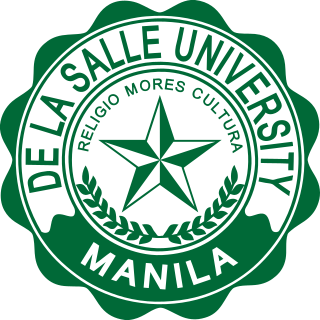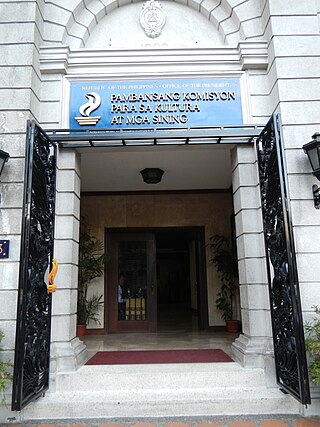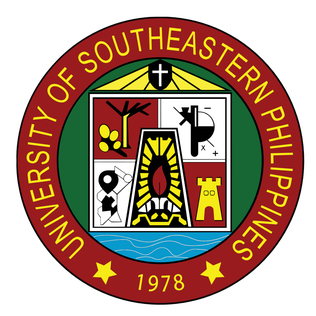
De La Salle University, also referred to as DLSU, De La Salle or La Salle, is a private, Catholic coeducational research university run by the Institute of the Brothers of the Christian Schools in Taft Avenue, Malate, Manila, Philippines. It was established by the Christian Brothers in 1911 as the De La Salle College (DLSC) in Nozaleda Street, Paco, Manila with Blimond Pierre Eilenbecker, FSC serving as director, and is the first De La Salle school in the Philippines. The college was granted university status on February 19, 1975, and is the oldest constituent of De La Salle Philippines (DLSP), a network of 16 educational institutions, established in 2006 replacing the De La Salle University System.
The culture of the Philippines is characterized by cultural and ethnic diversity. Although the multiple ethnic groups of the Philippine archipelago have only recently established a shared Filipino national identity, their cultures were all shaped by the geography and history of the region, and by centuries of interaction with neighboring cultures, and colonial powers. In more recent times, Filipino culture has also been influenced through its participation in the global community. "

The National Commission for Culture and the Arts of the Philippines is the official government agency for culture in the Philippines. It is the overall policy making body, coordinating, and grants giving agency for the preservation, development and promotion of Philippine arts and culture; an executing agency for the policies it formulates; and task to administering the National Endowment Fund for Culture and the Arts (NEFCA) – fund exclusively for the implementation of culture and arts programs and projects.

Lauro "Larry" Zarate Alcala was a well-known editorial cartoonist and illustrator in the Philippines. In 2018, he was posthumously conferred the National Artist for Visual Arts title and the Grand Collar of the Order of National Artists.

De La Salle University–Dasmariñas also referred to by its acronym DLSU-D or La Salle–Dasma; is a private Roman Catholic, Lasallian co-educational secondary and higher education institution run by the De La Salle Brothers of the Philippine District of the Christian Brothers in Dasmariñas, Philippines. It is a member of De La Salle Philippines, a network of 16 Lasallian educational institutions.

The Mindanao State University – Iligan Institute of Technology, commonly referred to as, is a public coeducational institution of higher learning and research university located in Iligan City, Philippines, charted in 1968 by Republic Act 5363 and integrated as the first autonomous unit of the Mindanao State University System in 1975.

Traditional Filipino games or indigenous games in the Philippines are games that have been played across multiple generations, usually using native materials or instruments. In the Philippines, due to limited resources for toys, children usually invent games without needing anything but players.There are different kinds of Philippine Traditional Games that are suited for kids, and the games also stand as one of the different culture and/or traditional games of the Philippines. These games are not only fun to play, but these games are also good for you. This is because different games require different skills. These games are also an important part in Filipino culture.

The University of Science and Technology of Southern Philippines is a state university system in the Philippines established on August 16, 2016, by virtue of Republic Act 10919 through the amalgamation of the Mindanao University of Science and Technology (MUST) in Cagayan de Oro and the Misamis Oriental State College of Agriculture and Technology (MOSCAT) in Claveria, Misamis Oriental. Both campuses are located in Northern Mindanao, considered the Gateway to Mindanao, which offers a strategic locational advantage for the institution to train and develop students from all the other regions of Mindanao.

The University of Southern Mindanao, formerly Mindanao Institute of Technology (MIT), is a university in the Southern Philippines. It provides instruction and professional training in the fields of science and technology, particularly agriculture and industry. The university was founded by Bai Hadja Fatima Matabay Plang, an educator and philanthropist. It formally open on October 1, 1954, and achieved university status on March 13, 1978. Its 1,024 hectare main campus is located in Kabacan, Cotabato. The University of Southern Mindanao is one of the four State University and Colleges (SUC) to achieve excellence in agricultural education and one of the nine to hold Level IV status. Across its 3 campuses USM holds a total of 5,129.97 hectares of land, mostly for agricultural teaching and research.

The University of Southeastern Philippines (USeP); Cebuano: Kinatumhaan sa Habagatan Sidlakang Pilipinas, Filipino: Pamantasan ng Timog-Silangang Pilipinas) is a public, research, coeducational, regional state university based in Davao City, Davao del Sur, Philippines. Founded on December 15, 1978, the university is an integration of four state educational institutions: Mindanao State University-Davao, the University of the Philippines-Master of Management Program in Davao, the Davao School of Arts and Trades, and the Davao National Regional Agricultural School. It was the first state university in Davao Region.
The Samahang Kartunista ng Pilipinas or SKP is an organization of comic strip cartoonists and editorial cartoonists founded in 1978.
Ani ng Dangal or "Harvest of Honors" is an organizational award given by the National Commission for Culture and the Arts, an agency under the Office of the President of the Republic of the Philippines. It is an annual event in the Philippines celebrated as a highlight and concluding rite of the Philippine Arts Festival.

The National Living Treasures Award, alternatively known as the Gawad sa Manlilikha ng Bayan, is conferred to a person or group of artists recognized by the Government of the Philippines for their contributions to the country's intangible cultural heritage. A recipient of the award, a National Living Treasure or Manlilikha ng Bayan is "a Filipino citizen or group of Filipino citizens engaged in any traditional art uniquely Filipino, whose distinctive skills have reached such a high level of technical and artistic excellence and have been passed on to and widely practiced by the present generations in their community with the same degree of technical and artistic competence."

The University Center for Culture and the Arts (UCCA) is a non-profit cultural center of the Polytechnic University of the Philippines. The agency is under the Office of the Vice President for Student Services. The UCCA is currently residing at the PUP Theater inside the PUP College of Communication compound.
Intangible cultural heritage (ICH) includes traditions and living expressions that are passed down from generation to generation within a particular community.

Far Eastern College – Silang, more known as FEU Cavite, is a private nonsectarian basic and higher education institution located in MetroGate Silang Estates, Silang, Cavite, a municipality 43 kilometres (27 mi) south of Manila, Philippines. Established in 2009, it is the first subsidiary of the Far Eastern University (FEU) outside of Metro Manila.

Wilfredo O. Pascual Jr. is an internationally acclaimed essayist, winner of the Curt Johnson Prose Award for Nonfiction and a runner-up to the Steinberg Essay Prize. In 2016, he was nominated for the Pushcart Prize and Best of the Net. He grew up in the Philippines where his essays have won several national awards, including the Palanca's grand prize twice and the Philippine Free Press Literary Awards. He is also a board of trustees adviser and member of the Samahang Makasining, Inc. since 2005.
Imelda Cajipe-Endaya is a Filipino visual artist, curator, author, activist, and community leader. She is known for her printmaking, painting, mixed-media art, and installation art. She is also an author of various texts and books, as well as the co-founder of Kasibulan, an artist collective in the Philippines. She also initiated the Pananaw Philippine Journal of Visual Arts, of which she was the first editor. Imelda Cajipe-Endaya has become a main figure Filipino feminist and national liberation movements and Philippine art. Her advocacy of women centers around Philippine history and culture.

Ramón Valera was a Filipino fashion designer who was bestowed with the National Artist of the Philippines honor in 2006. He is the first Filipino fashion designer to receive this distinction. In 2017, his work was displayed in an exhibit called Valera and the Modern: An Exhibit on the Life and Work of National Artist for Fashion Design, Ramon Valera which was curated by Gerry Torres at De La Salle-College of St. Benilde’s School of Design and Arts Gallery.













